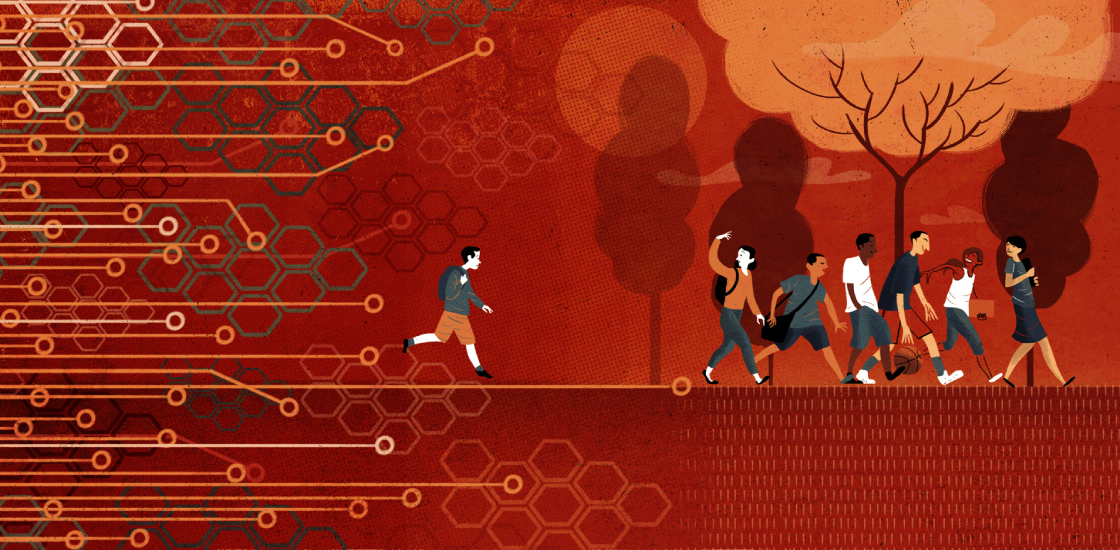Technology can curb social exclusion of children with autism
Apps, robots and brain imaging can help children with autism improve their social skills and connect with other people.

In September, the Florida State University football team made a visit to a Tallahassee middle school that would become famous. At lunchtime, student-athlete Travis Rudolph noticed sixth grader Bo Paske eating alone, so he joined Bo for the meal. Bo, who has autism, often sat by himself in the lunchroom.

Life Science
Autism research and the real world.
The world took note of the athlete’s gesture after his mother’s Facebook post about it went viral. “This is one day I didn’t have to worry if my sweet boy ate lunch alone, because he sat across from someone who is a hero in many eyes,” she wrote.
This story touched people because it calls to mind something universal: the sting of social exclusion. We have all known children who often eat, or play, alone. And all of us have felt left out at one time or another.
But although this experience may be universal, a new generation of children is experiencing a wave of inclusiveness. Technology of various types, often thought of as an isolating influence, can actually abet people’s good intentions or help those with autism learn to fit in.
One new app called Sit With Us, invented by 16-year-old Natalie Hampton, helps vulnerable children who have difficulty finding a welcoming group in the lunchroom. Its motto is inspiring: “The first step to a warmer, more inclusive community can begin with LUNCH.” Sit With Us allows students to designate themselves as ‘ambassadors’ and to signal to anyone seeking company that they’re invited to join the ambassador’s table.
Beyond apps, groundbreaking research into technology-based interventions for autism could boost the social skills of children with developmental conditions. Such technologies may help these children make friends once they sit down at the table.
Socializing with robots:
One promising approach involves interactive robots that help teach children with autism how to navigate social situations. My colleagues and I at George Washington University are encouraging about two dozen children with autism to communicate with humanoid robots that detect and analyze the children’s actions and respond in ways that reinforce social learning. The robots use personalized gestures and vocal cues to provide interactions that are rewarding to the children.
These robots engage children socially in a safe setting, providing practice in social skills. They also may enhance ‘brain readiness’ for social training, maximizing the benefits of evidence-based behavioral interventions. Children who might otherwise be reluctant to enter a social situation often feel comfortable interacting with a robot, which is more predictable and nonjudgmental. Plus, who doesn’t love robots?
Our initial results show that interacting with the robots engages a cascade of neural systems that support successful social perception and exchanges. We are using various brain imaging techniques to determine whether the robots, along with a skilled therapist, can prime social brain circuits to respond during behavioral treatment.
Robots therefore may serve as a bridge into a reward and motivation system in the brains of children with autism. They may direct a child’s attention toward socially relevant features of a situation and shape social brain responses.
Robots also may be useful in targeting sensory issues. Children with autism often feel overwhelmed or anxious in the presence of loud music, bright lights or strong smells. Interacting with robots that provide carefully calibrated stimuli and adapt to the child’s reactions in real time could help children with autism learn to cope with and communicate these sensory problems.
Chung-Hyuk Park, a roboticist at George Washington University, is experimenting with various types of robots to determine how best to use them to enhance the effectiveness of treatment for social communication problems in children with autism. Park and I, along with Jennifer Frey, a psychologist and special education professor, are also exploring ways to meaningfully incorporate robots into existing evidence-based behavioral interventions.
Seeing solutions:
Neuroimaging technology, which allows scientists to explore the neural activity associated with behavior, may also provide insights into how to help children with autism regulate their feelings and thoughts.
This technology has shown us, for example, that social exclusion hurts both typical individuals and people with autism, but for different reasons. Typical adolescents and young people with autism rated exclusion by peers in a computerized game of catch called ‘Cyberball’ as equally upsetting. But the brain scans for the two groups were different.
The typical teens show robust activity in regions involved in social reasoning and regulating negative emotions. On the other hand, scans from teens with autism reveal the involvement of structures that keep track of nonsocial rules and rule violations. In these children, the brain systems involved in negative emotions come alive only secondarily.
This difference suggests two paths for helping people cope with being left out. Typical children may benefit from understanding why others may hurt their feelings, intentionally or not. By contrast, a person with autism may find more value in a discussion of the ways in which we manage our expectations for following rules, the relative importance of different rules, and why other people violate what seem to be clear-cut rules to accomplish their own goals.
At the same time, ‘neurotypicals’ might benefit from learning — perhaps from our neuroimaging findings or articles by autism self-advocates — how to better meet the social expectations of people with autism. These sources can also reveal ways to celebrate diversity in behavior and practice inclusiveness.
Neuroimaging technology could also help tailor behavioral interventions to individual children. In a study published in November, my colleagues and I at George Washington University discovered a pattern of brain activity during a social perception task that predicts which children will respond to pivotal response treatment, an evidence-based behavioral therapy for children with autism.
Too often we talk about how technology disengages us from our surroundings. But it also can help our children connect with one another, be more effective self-advocates and support their own decision-making and independence. In its emergence as a vital tool for eliminating exclusion and promoting understanding, technology is, in fact, helping us all embrace our greater humanity.
Kevin Pelphrey is Carbonell Family Professor and director of the Autism and Neurodevelopmental Disorders Institute at George Washington University and Children’s National Health System in Washington, D.C.
Syndication
This article was republished in Scientific American.
Recommended reading

New organoid atlas unveils four neurodevelopmental signatures

Glutamate receptors, mRNA transcripts and SYNGAP1; and more

Among brain changes studied in autism, spotlight shifts to subcortex
Explore more from The Transmitter

Not playing around: Why neuroscience needs toy models
